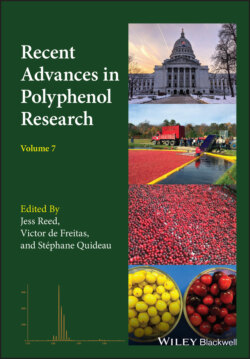Читать книгу Recent Advances in Polyphenol Research - Группа авторов - Страница 38
2.3.6.2 Synthesis of Procyanidin A2 (3)
ОглавлениеThe protocol described earlier (Figure 2.20) was applied to the synthesis of procyanidin A2 (3) (see Figure 2.5), in which a nucleophilic monomer unit needed to be selectively protected (vide infra). The present authors have developed a de novo synthetic approach to the epi‐type catechins (Figure 2.22) (Stadlbauer et al. 2012), relying on the ortho‐metalation of aryl fluoride I (#1) and reaction with epoxy alcohol II, followed by an SNAr oxycyclization of adduct III to give flavan IV (#2). This protocol enabled access to monomer unit 52 with a free hydroxy group at C(7) (Figure 2.23) (Ito et al. 2014). Starting from 1,3,5‐trifluorobenzene (47), sequential substitutions with t‐BuOK and BnOK gave mono‐fluoride 48. Regioselective lithiation of 48 followed by the reaction with epoxy alcohol 49 in the presence of BF3·OEt2 gave adduct 50. After the protecting group arrangement, the resulting alcohol 51 was subjected to the pyran‐ring formation. Treatment of 51 with KH cleanly afforded the cyclized product, which was exposed to acidic conditions to give the monomer unit 52, which was employed as the nucleophilic flavan unit in the following annulation (Figure 2.24). Upon treatment of a mixture of 34 and 52 with BF3·OEt2, the corresponding annulation product 53 was obtained in excellent yield. Notably, none of other regio‐ and stereoisomers was observed. As the α‐face of the electrophilic flavan unit 34 is shielded by the C(3)‐substituent, nucleophile 52 approached from the β‐side to form the double linkages at the C(2) and C(4) positions. In addition, the nucleophile 52 selectively reacted at its C(8) position rather than the C(6) position. Finally, all protecting groups were removed to give procyanidin A2 (3).
Figure 2.21 Pettus's diinsininol aglycon synthesis.
Figure 2.22 Strategy for monomer synthesis.
Figure 2.23 De novo synthesis of the C(7)‐hydroxy monomer unit.
Figure 2.24 Total synthesis of procyanidin A2 via flavan annulation.
More recently, it was found that the annulation could work even with a non‐protected flavan unit, e.g. catechin or epicatechin, as a nucleophile (Figure 2.25) (Betkekar et al. 2019). In a solvent mixture of ethanol and 1,4‐dioxane, (–)‐epicatechin was allowed to react with electrophilic flavan unit 54 in the presence of camphor sulfonic acid, affording annulation product 55 along with minute amounts of its regioisomers 56 and 57. After chromatographic separation (silica gel) and deprotection, all products were converted to their free‐forms, i.e. procyanidin A2 (3), proanthocyanidin A6, and proanthocyanidin A7.
Figure 2.25 Annulation with a free flavan unit and syntheses of procyanidin A2, and proanthocyanidin A6 and A7.
These results indicate that the free flavan unit preferentially reacted at its C(8) position rather than the C(6) position. To address the origin of this C8/C6‐regioselectivity, a DFT calculation was conducted on the putative Wheland intermediates II and III, generated by the reaction on the model substrate I with CH3+ (Figure 2.26). The result suggested that the C8‐methyl intermediate II is energetically more stable over the C6‐counterpart III.
Figure 2.26 DFT calculations of the Wheland intermediates, II and III, derived from model compound I.
